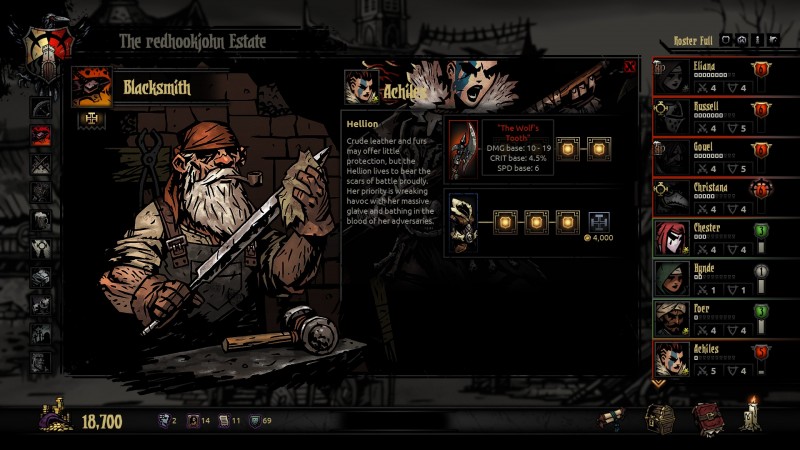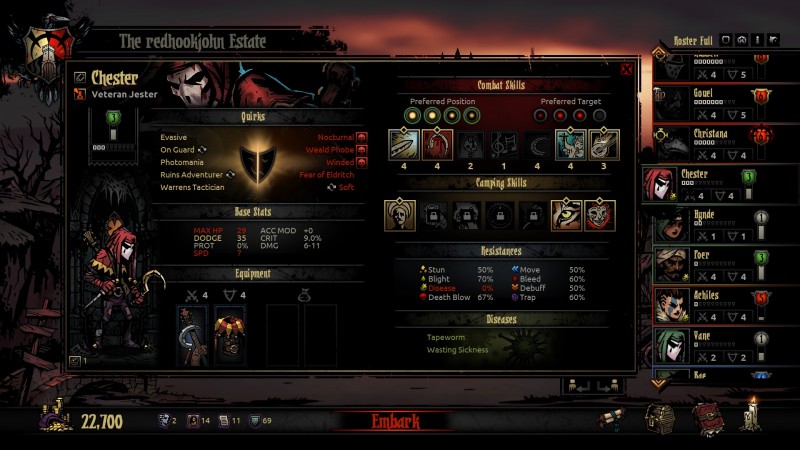Our extra-large special edition is here. Subscribe today and receive the 25% longer issue at no extra cost!
Read These Life-Saving Darkest Dungeon Tips Or Venture At Your Own Peril

If you’re heading into Red Hook Studio’s Darkest Dungeon, you’ll probably be sending tons of poor heroes off to their demise before you start putting things together. It has a lot to take in, from finding out which item works with what object inside the dungeons to crafting powerful team compositions with the perfect set of skills. While a lot of the fun in Darkest Dungeon comes from figuring things out for yourself and taking down the big bosses, we’re here to give you a solid starting base of knowledge to work with, so that while your characters may lose their sanity along the way, you won’t. Join us for some Darkest Dungeon survival tips.
The Hamlet
The Hamlet is your base of operations. When you go out adventuring, you’ll be constantly collecting various pieces that can be spent here to improve your buildings and their associated offerings. You should focus on getting the maximum roster size and carriage offerings (the number of new heroes that show up to your town each week) as top priority so you can assemble better teams. As the costs for that get more steep, consider investing in weapon and skill upgrades to make life easier, and pick ONE row of stress reducing options to max out and focus on it – this will make it cheaper to cure stress problems if you have them.
Don’t worry about removing negative traits and quirks from your heroes early in the game – it’s extremely expensive and unless you’re losing a level 6 champion with great trinkets, more flesh is readily available on the cart. You don’t have the money for it; don’t waste it. Upgrade your weapons and skills instead. After you’ve maxed out all your essential buildings, you can dump the rest of your heirlooms into the campfire specialist (who can swap out your hero’s camp-associated skills for new ones) and trinket vendor.

The Cast of Characters
All of the characters in Darkest Dungeon are good at something, and you’ll want to diversify a bit. You’ll soon learn that some characters specialize in various kinds of attacks and buffs. For example, the Occultist has abilities that make him very effective against Eldritch creatures, like those found in the Cove dungeon, so it’s a natural fit to bring one along on that mission or when you think you’re going to take on a Shambler (we’ll talk about that later). Other heroes that focus on bleeds like the Houndmaster may be a poor choice for the Ruins, which is filled with skeleton creatures (Hint: Skeletons don’t bleed, they are made of bones.). Your characters “roll” with four skills off the cart, but you can train and upgrade any skills you wish at the guild hall for a price.
You’ll also have to consider character positioning, as it is critical to success; certain moves can only be executed in certain slots (1-4), and the enemy will constantly be trying to shift you around and mess up your order. Some characters are versatile and can be effective in any position. Others, like the melee-loving leper, are in deep trouble if they get stuck in the back. Having a few characters with positional abilities that allow them to move AND execute a maneuver in the same action can be beneficial to your survival. I encourage you to try all kinds of combinations out, but be advised that it’s often a good idea to bring along a character with some kind of heal or stress reducer on your journey – the plague doctor’s cure may not heal any real hit points, but removing a massive bleed or blight can be extremely important (just ask those crabs in the Cove Tier 2 and 3…). Get creative and pick teams that can buff and complement each other. One of my favorite compositions is Plague Doctor, Abomination, Abomination, Man At Arms. The Plague Doctor can wreak havoc on the backline with a two-position plague bomb and stun while keeping bleeds and blights away; the abominations have an excellent stun and self-heal while in human mode and can go beast mode when the situation calls for it; and the Man At Arms takes the upfront hits, buffs the team, and has a versatile three-position melee attack.

Dungeons
Four basic dungeons are available to tackle with a huge range of quests and tasks. Quests come in three flavors: short, medium, and long. You’ll be able to camp once during a medium mission and twice in a full-scale mission. The rewards are generally much better for the longer runs, but so are the risks. Camping will allow you to buff characters up, heal them, and reduce stress – this is especially important to do before moving into a boss chamber. Boss chamber logic (how they spawn) will become obvious to you after a few boss mission runs; it’s almost always the “last” room on the map (farthest from the starting room). You can pretty much just eyeball it and know after you get the hang of it, but scouting always helps. Speaking of which, scouting is a really, really important ability, so if you find a trinket or camping skill that can buff it, you may want to look into it.
Knowing what’s coming in the hallways and rooms ahead is invaluable, so keep that torch lit. This will let you prepare to disarm traps, avoid ambushes, and shoot right for the valuable rooms. Dungeons also have their own little quirks that you’ll learn in time and should be taken into consideration. The ruins is full of skeletal undead, so bleeding won’t do you much good. The warrens is filled with disease, so don’t let the little pigs vomit on you or you’ll find yourself sick. The ruins have a ton of locked cabinets – so bring keys. You will also run into a ton of various interactive objects on the way that can do various things, but sometimes having a certain item can make it so you always get a positive outcome. I highly recommend checking out a wiki if you’re not sure. Remember: Torch stands, bags, and crates are ALWAYS safe to open.
The biggest rule of dungeon crawling is to be prepared and don’t take any chances; there’s no time limit on your save file and it’s almost always better to keep your crew alive by running away if things look bad (unless you’re actually just trying to get them killed or plan to banish them). Your torches will tick down as you battle and move about the dungeon, but don’t worry they’re not on actual “timers” – they won’t burn down as you sit still if you need to let the dog out or something. It’s important to know that Darkest Dungeon features a system to prevent you from “outleveling” content, as level-3 heroes will refuse to do apprentice level runs, and level-5 heroes will refuse to engage in veteran level content, so always try to do boss runs with teams that are at max level for the difficulty, i.e. level-2 team for apprentice, level-4 team for veteran, and level 6-team for champion and Darkest Dungeon. Note that new monsters start showing up in Veteran dungeons that you will not have encountered in apprentice runs, so be prepared for serious new challenges.

Light Levels
The name of the game is Darkest Dungeon, right? So you may not want to play in the dark. Light levels have an impact on a variety of things, and the easiest and most obvious way to play is by spending some cash on torches before setting foot into dungeons – keeping your light levels high means you’ll be surprised by foes less and it will give you a scouting bonus so you can see what’s up ahead. If you choose to get a little wild you can try a “dark” run, playing with low or no light levels. This means you’ll find a lot more loot and dish out more crits, but enemies will surprise you and your team will suffer additional stress damage. In addition to those mechanics, there’s a very small chance that when you’re playing in a no-light situation that a Shambler “mini” boss will creep up on you – that’s generally a really bad thing, though they do drop nice items if you can take them on. Note that you can also summon Shamblers to farm them for trinkets at special summon spires by throwing a torch inside them; make sure your team is ready for a fight if you wish to engage.
Trinkets
Trinkets range in rarity and can be found all over, from dungeon quest completions to special drops. The game’s lesser trinkets often confer minor bonuses or offer the player a tradeoff, i.e. more of one stat but a penalty to another. Don’t overrate damage, and keep your eye on accuracy and speed – these stats will save your life and win you battles. Very rare trinkets will become the norm as you reach the late game, and you will also have the chance to get some extremely rare trophy items from Champion-tier (level 5-6) boss kills that offer serious and powerful benefits – perfect for your Darkest Dungeon team. Always, always, always unequip your trinkets using the handy “unequip all” button when you get back to town before putting your team into stress-healing locations, as they may lose items when gambling or drinking.

Bosses
While all the bosses have unique mechanics, the majority of them feature some sort of system where you’ll need sustained damage. One of the easiest methods to tackle most bosses is to have your melee fighters smash the soft targets in front that require your attention while stacking up a bleed or blight on the boss to drain them down. Knowing your boss weaknesses is important (you won’t be able to bleed or blight the cannon, for instance), and sometimes it’s actually better just to go all out on the boss and ignore the side mechanics if your team can dish out hard and heavy punishment (this is a good strategy for the Hag for some team compositions). You may also run into “The Collector” while roaming the dungeon halls, an encounter you should treat with the respect of a full-fledged boss encounter.

Get the Game Informer Print Edition!
Explore your favorite games in premium print format, delivered to your door.
- 10 issues per year
- Only $4.80 per issue
- Full digital magazine archive access
- Since 1991









